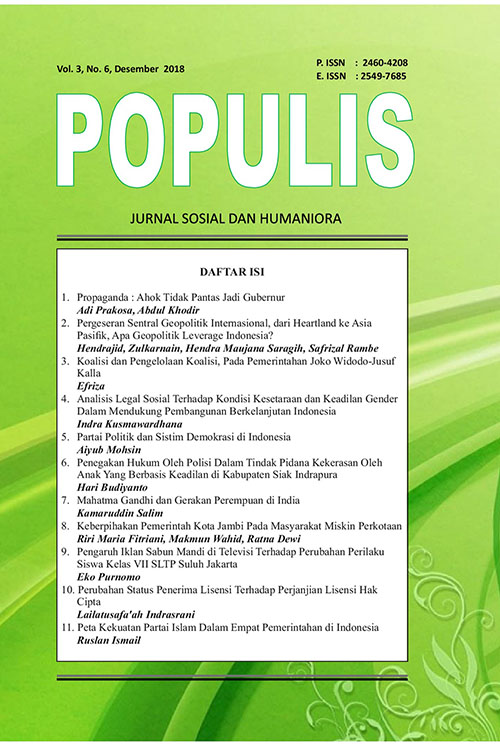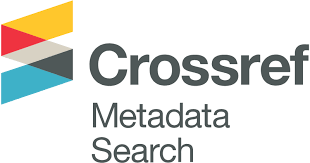PARTAI POLITIK dan SISTIM DEMOKRASI DI INDONESIA
DOI:
https://doi.org/10.47313/pjsh.v3i2.476Abstract
The Republic of Indonesia since 1945 when it proclaimed its independent from the Dutch colonialism adopted democracy as political system. In its political development, democracy in Indonesia had many names or label. From 1945 until 1959, the Republic of Indonesia adopted and implemented which is commonly known as Liberal Democracy. During the period of 1945 – 1959, the government of Indonesia held successfully general election with 39 political parties as well as mass organization and group of constituens which all together 100 participants in the general election. From 1959 until 1966, democracy which was took on called Guided Democracy.During this period there was no general election eventhough some political parties were permitted to exist by the current rezime . The rezime was of the opinion that the Indonesian people was not ready yet for carrying out generah election. After aborted Communist coup d’etat at 30 September 1965, new government arised, and they called their government as New Order or Orba in Bahasa Indonesia. The new order remained to adopt democracy in political system which was labelled as Democracy Pancasila, referred to the nation and state philosophy. The new order government organized six times general election which was held in 1971 1977, 1982, 1987, 1992 and 1997. In general election 1973 there was 10 political parties and 1 mass organization called Golkar, formed by government as main political power of Orba. Since 1977 the election participants were only two parties, the United Party for Development (PPP), the Indonesian Democratic Party (PDI) and Golkar. Then Golkar developed as hegemonic party, ardent and strong supporter to the Orba government, and always winning in every general election. When Reformation Era came in 1998, the reformation government named its democracy as Demokrasi Reformasi, and as of 1998 until now, had successfully organized 4(four) times general elections with its participants fluctuated. In 1999’s general election the participants was 48 political parties, 2004’ election was 24 parties, 2009’ s election was 38 parties, 2014’ general election was 12 parties. For 2019’ s general election, 16 parties was declared by the General Election Commission or KPU as participants nationally.
From theoretical perspectives on democracy, whatever labelled or named, democracy implemented in Indonesia formally as DEMOCRACY.
Key words : Democracy. Political Parties, General Election.
References
Ambardi, Kuskridho, Mengungkap Politik Kartel, studi tentang Kepartaian di Indonesia Era Reformasi, Jakarta: Gramedia, 2008.
Dhakidee, Daniel, eds, Partai-Partai Politik Indonesia, Ifeologi dan Program, 2004-2009, Jakarta: PT Kompas, 2011.
Feith, Herbert, Pemilu 1955 di Indonesia, Jakarta: Gramedia, 1999.
Evans, Kevin Raymond, Sejarah Pemilu dan Partai Politik di Indonesia, Jakarta: PT Arise Consultance, 2003.
Naru Darusima, Sejarah Revolusi Kemerdekaan, Pemilihan Umum 1955, Jakarta: Jurnal Sejarah Net, November 2004.
Pamungkas, Sigit, Partai Politik, Teori dan Praktek di Indonesia, Yogyakarta: Institute for Democracy and Welfarism (IDW), 2012
Ridho Al Hamdi, Partai Politik Islam, Teori dan Praktek di Indonesia, Yogyakarta: Graha Ilmu, 2013.
Hilsman, Roger, the Politics of Governing America, New Jersey: Prentice-Hall. 1985, page 446 – 453.
Downloads
Published
Issue
Section
License
- Hak publikasi atas semua materi informasi yang tercantum dalam situs jurnal ini dipegang oleh dewan redaksi/editor dengan sepengetahuan penulis. Pengelola Jurnal akan menjunjung tinggi hak moral penulis.
- Aspek legal formal terhadap akses setiap informasi dan artikel yang tercantum dalam situs jurnal ini mengacu pada ketentuan lisensi Creative Commons Atribusi-NonCommercial-No Derivative (CC BY-NC-ND), yang berarti bahwa hanya dengan izin penulis, informasi dan artikel Jurnal BACA dapat didistribusikan ke pihak lain dengan tanpa merubah bentuk aslinya untuk tujuan non-komersial.
- Setiap terbitan Populis Jurnal Sosial dan Humaniora, baik cetak maupun elektronik, bersifat open access untuk tujuan pendidikan, penelitian, dan perpustakaan. Di luar tujuan tersebut, penerbit atau pengelola jurnal tidak bertanggung jawab atas terjadinya pelanggaran hak cipta yang dilakukan oleh pembaca atau pengakses.










